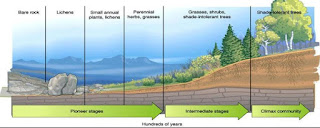Lichen stage definition
A simple slow-growing plant that typically forms a low crusty, leaflike, or branching growth on rocks, walls, and trees.
Crustose Lichen Stage
A bare rock consists of solid surface or very large boulders and there is not place for rooting plants to colonize. The crustoose lichens can adhere to the surface of rock and absorb moisture from atmosphere.
Therefore these colonize the bare surfaces of rock fast. The propagules of these lichens are brought by the air from the surrounding areas. These lichens produce acids which corrode the rock and their thalli collect windblown soil particles among them that help in formation of thin film of soil. When these lichens die their thalli decomposed to humus. This promotes soil building and the environment becomes suitable for growth of foliose and fruiticose type of lichens.
Foliose and Fruiticose Lichen Stage
Foliose have leaf like thalli while the fruiticose lichens are small bushes. They are attached by the substratum at one point only. Therefore do not cover the soil completely. They can absorb and retain more water and are able to accumulate more dust particles. Their dead remains are decomposed to humus which mixes with soil particles and help building substratum and improving the soil moisture contents further. The shallow depreciation in the rocks and crevices become filled with sold establishment of mosses. This community includes Parmelia and Dermatocarpon etc. e.g. which have large leaf like thalli.
Moss Stage
The spores of xerophytic mosses are brought to the rock where they succeed lichens. Their rhizoids penetrate soil among the crevices, secretes acids and corrode the rock. The bodies of mosses are rich in organic and inorganic compounds. When they die they add these compounds to the soil to increase the fertility of the soil. Since mosses develop in patches they catch soil particles from air and help increasing substratum. The changing environment leads to migration of lichens and help invasion of herbaceous vegetation.
Herb Stage
Herbaceous weeds mostly annuals such as asters and evening primroses invade the rock. Their roots penetrate deep down, secrete acids and enhance the process of weathering. Leaf litter and death herbs add humus to the soil. Shading of soil results in decrease in evaporation and there is slightly increase in temperature. As a result the xeric conditions begin to change and biennial and perennials herbs and xeric grasses begin to inhabit. These climatic conditions favor growth of bacterial and fungal populations resulting in increase in decomposition activity.
Shrub Stage
Herb and gasses mixture is invaded by shrub species such as Rhus and others. Early invasion of shrub species is slow but once a few bushes have become established birds invade this area and help dispersal of shrub seeds. This results in dense shrub growth shading the soil and making conditions unfavorable for the growth of herbs which begin to migrate. The soil formation continues and its moisture contents enhance. The environment becomes mesic or moderately moist.
Tree Stage
Changes in environment favor colonization of tree species. The tree saplings begin to grow among the shrubs and establish themselves. The kind of tree species inhabiting this area depends upon the nature of the soil. In poorly drained soils oaks establish themselves. The trees form canopy and shade the area. Shade loving shrubs continue to grow as secondary vegetation. Leaf litter and decaying roots weather the soil further and add humus to it making the habitat more favorable for growth of trees. Mosses and ferns make their appearance and fungi population grows abundantly.
Climax Stage
The succession culminates in a climax community, the forest. Many intermediate tree stages develop prior to establishment of a climax community. The forest type depends upon climatic conditions.







Comments
Post a Comment